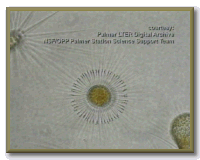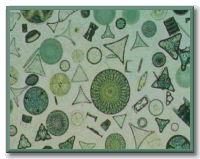Antarctica contains a surprising number and variety of lakes, ponds and pools. However, even the warmest lakes are frozen to depths of one or two meters for 8 to 12 months of the year, and some are always covered with ice. (See Dale Andersen's comments.) The ice cover limits the amount of light that can enter the lakes, thus restricting plant growth; where floating algae (phytoplankton) do occur, they are adapted to low light levels and have a peak of activity in early spring when the lakes are still ice-covered.
Nearly all Antarctic lakes have arisen as a result of glacial retreat, though a few have been formed by earth movements. The most recent freshwater bodies are found as short-lived pools in depressions on glaciers and ice fields. They contain no life.
|
|
Image courtesy of David Harwood |
As deglaciation uncovers bedrock, more conventional lakes can form. These contain pure water, with the addition of only small amounts of mineral salts from sea spray and leaching from the surrounding rock. There may be a sparse vegetation of blue-green algae and diatoms forming a felt on the bottom, and occasionally small water-fleas (for example, the Copepod (Pseudoboeckella poppei) are present.
Lakes that have been established longer are characterized by increased levels of nutrient salts in their water, though these are still very low. These "oligotropihic" lakes can support a crop of plants and hence animals, which feed on the plants or on detritus. When not kept clean by ice scour, the bottoms of such lakes are often partially or totally covered with a dense felt of blue-green algae and diatoms, and there may be rich growths of aquatic mosses.
|
|
WANT TO LEARN MORE?
|
|
Websites
• Ice Shelves Facts about ice shelves. • Antarctic Adventure 1997 Information on the geography and climate of Antarctica. • Meteorology A general description of the climate of Antarctica. |
![]()

